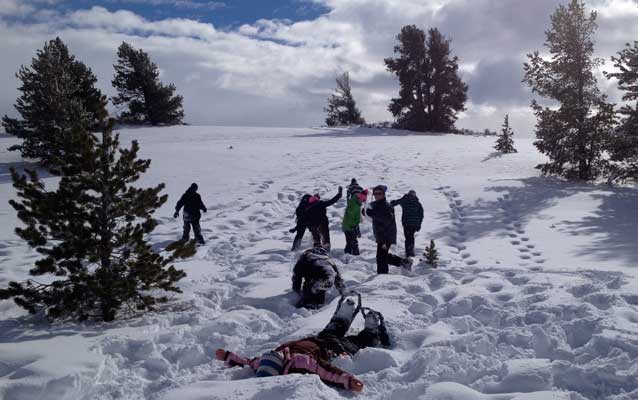Last updated: November 26, 2022
Lesson Plan
Winter Track Mystery: SnowSchool Post-visit Activity

- Grade Level:
- Upper Elementary: Third Grade through Fifth Grade
- Subject:
- Math,Science
- Lesson Duration:
- 60 Minutes
- State Standards:
- NATIONAL/STATE STANDARDS:
NGSS.SEP.2, NGSS.SEP.4, NGSS.SEP.6, NGSS.SEP.7, NGSS.SEP.8
Essential Question
What do animal tracks in the snow tell us about animal activity during the winter?
Objective
Students will use careful observation to identify and label multiple track sets in the track mystery diagram. They will then complete a series of questions based on their interpretation of the diagram using critical thinking and writing skills to support their answers.
Background
Reinforce the lessons your students learned during SnowSchool at Craters of the Moon with the Winter Track Mystery. This activity calls upon information learned in both the classroom and field sessions of their visit to the monument.
Preparation
Each student will need the following:
- Pen or pencil
-
Crayons or colored pencils
-
Winter Track Mystery worksheet
Materials
Download Winter Track Mystery Worksheet
Download Winter Track Mystery Teacher's Guide
Download Winter Track Mystery Answer Key
Procedure
Lead a brief discussion asking students to recall the variety of tracks they learned about during their trip to Craters of the Moon. The list should include: fox, coyote, squirrel, chipmunk, rabbit, mouse, as well as others.
Ask students to describe some of the track patterns they saw in the snow. Alternatively, draw two or three sets of tracks on a whiteboard or overhead projector and ask students to guess what animal made them. Ask students to think about how some animals move. Those that bound or hop (including squirrels, rabbits, and chipmunks) leave tracks in sets of four that repeat. Animals that walk (including foxes, coyotes, and humans) tend to leave a single track that repeats.
Also review with students the three methods animals have to deal with winter:
Escape - Also known as migration, this method is common among birds including mountain bluebirds and swallows. Large mammals like mule deer and pronghorn migrate over shorter distances.
Avoid - Many avoiders hibernate. Bears, marmots, ground squirrels, reptiles, and insects all hibernate to avoid winter hazards. Mammals that hibernate often eat lots of food to add fat layers before winter, then burn them off slowly in lieu of eating. Others, such as pika, do not hibernate. Instead, pika sleep more and spend more time underground in their dens to avoid winter's worst aspects.
Adapt - Adapters include foxes, coyotes, bobcats, red squirrels, rabbits and hares, ravens, golden eagles, and humans. They adapt by adding extra layers of fur (extra clothes in the case of humans) or fluffing out feathers.
Assessment Materials
Participation in activity and completion of worksheet.
Enrichment Activities
By the completion of this activity all students should know that the tracks they find in the snow are left by creatures that adapt to deal with winter conditions.
Contact Information
Success
Thank you. Your feedback has been received.
Error
alert message

